Public Relations and Propaganda: Comparative Analysis of Strategies
VerifiedAdded on 2020/03/16
|7
|1460
|273
Essay
AI Summary
This essay provides a comprehensive comparative analysis of public relations and propaganda, exploring their definitions, historical contexts, and strategic applications. The essay highlights that public relations and propaganda are both communication and management tools used to influence public perception, although they differ in their approaches and ethical considerations. Public relations aims to build sustainable relationships and brand loyalty by presenting factual information, while propaganda often employs emotional appeals and half-truths to achieve specific objectives. The essay discusses the use of media platforms, systematic planning, and persuasive techniques common to both strategies. It also examines their impact on political, social, and economic spheres, while acknowledging the potential for abuse. The essay concludes by emphasizing the importance of ethical considerations and responsible use of these communication strategies.
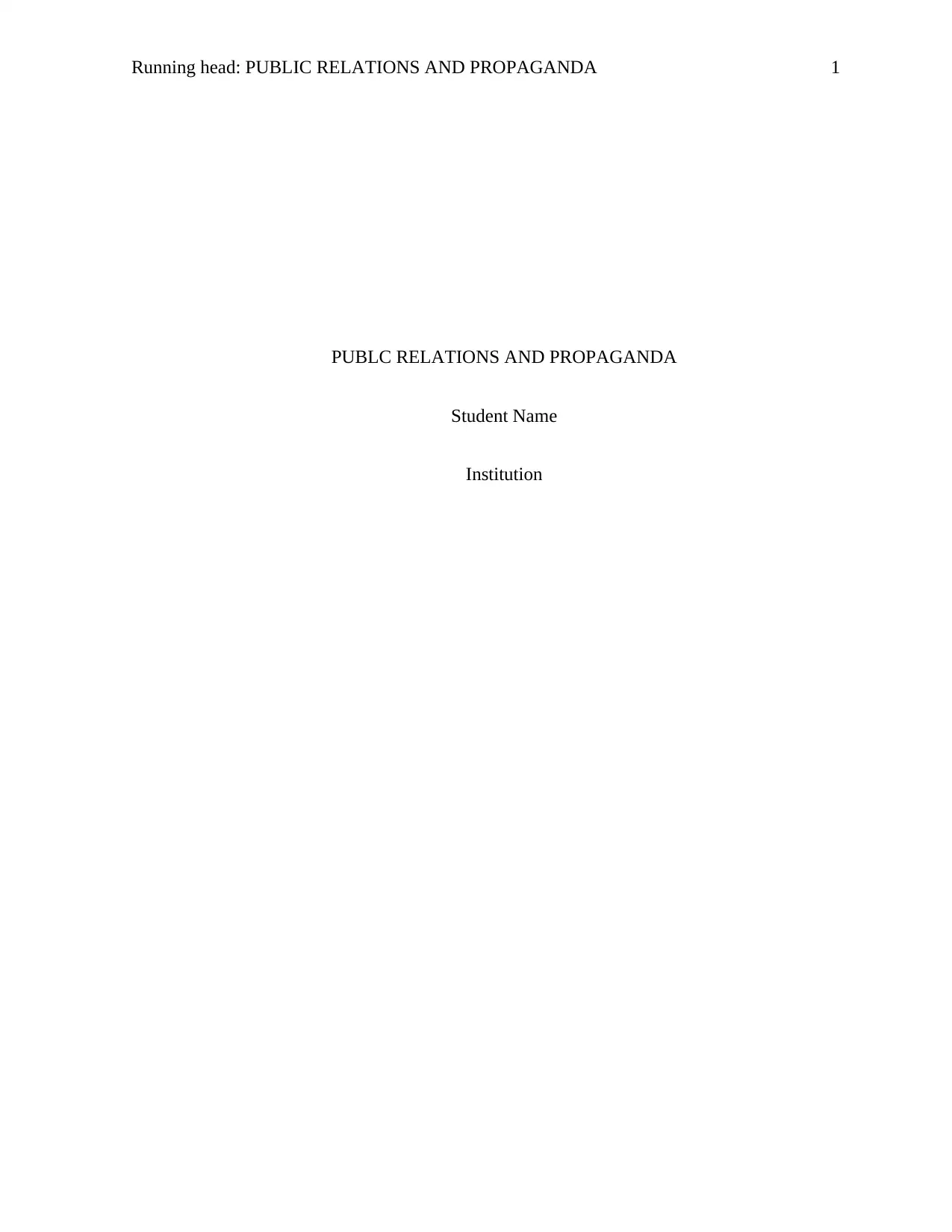
Running head: PUBLIC RELATIONS AND PROPAGANDA 1
PUBLC RELATIONS AND PROPAGANDA
Student Name
Institution
PUBLC RELATIONS AND PROPAGANDA
Student Name
Institution
Paraphrase This Document
Need a fresh take? Get an instant paraphrase of this document with our AI Paraphraser
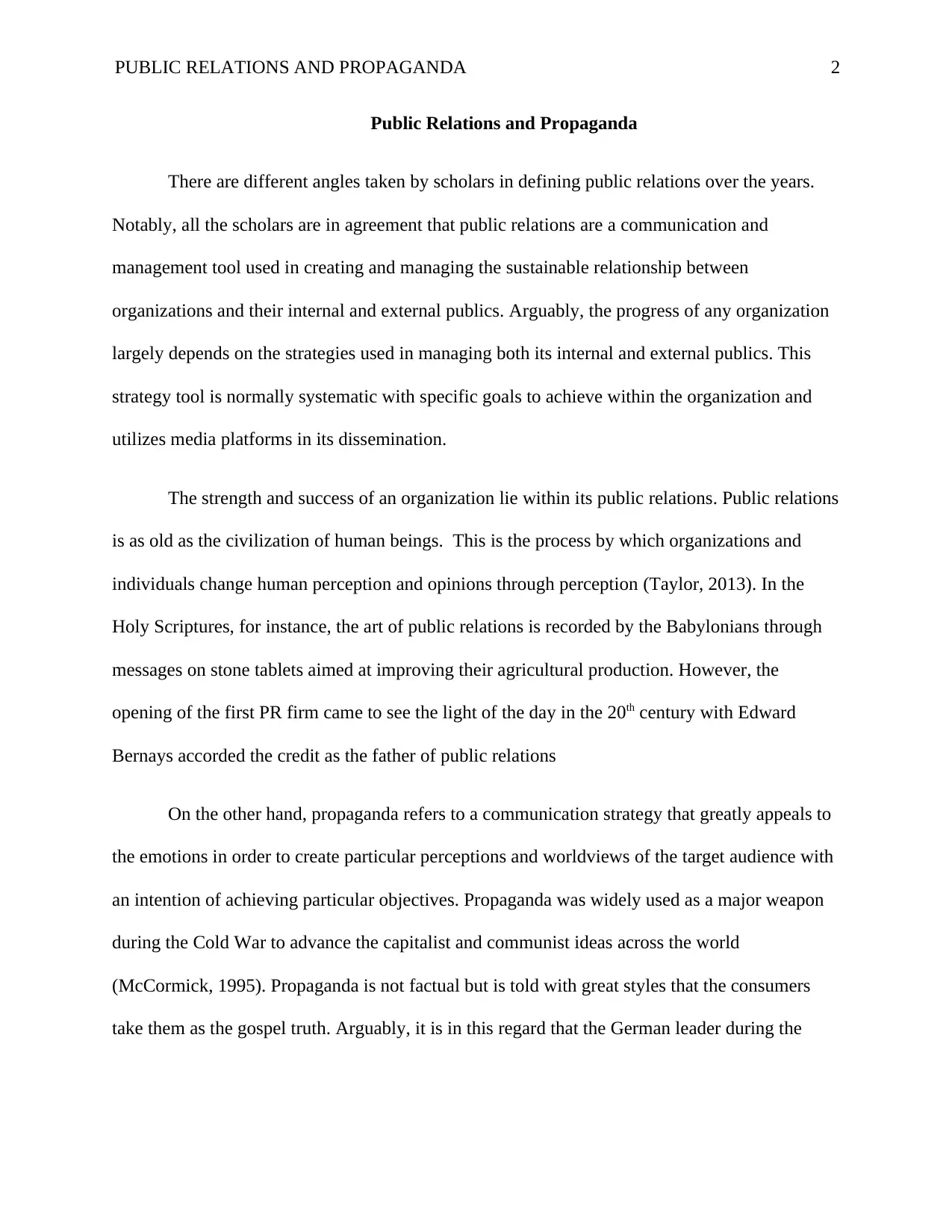
PUBLIC RELATIONS AND PROPAGANDA 2
Public Relations and Propaganda
There are different angles taken by scholars in defining public relations over the years.
Notably, all the scholars are in agreement that public relations are a communication and
management tool used in creating and managing the sustainable relationship between
organizations and their internal and external publics. Arguably, the progress of any organization
largely depends on the strategies used in managing both its internal and external publics. This
strategy tool is normally systematic with specific goals to achieve within the organization and
utilizes media platforms in its dissemination.
The strength and success of an organization lie within its public relations. Public relations
is as old as the civilization of human beings. This is the process by which organizations and
individuals change human perception and opinions through perception (Taylor, 2013). In the
Holy Scriptures, for instance, the art of public relations is recorded by the Babylonians through
messages on stone tablets aimed at improving their agricultural production. However, the
opening of the first PR firm came to see the light of the day in the 20th century with Edward
Bernays accorded the credit as the father of public relations
On the other hand, propaganda refers to a communication strategy that greatly appeals to
the emotions in order to create particular perceptions and worldviews of the target audience with
an intention of achieving particular objectives. Propaganda was widely used as a major weapon
during the Cold War to advance the capitalist and communist ideas across the world
(McCormick, 1995). Propaganda is not factual but is told with great styles that the consumers
take them as the gospel truth. Arguably, it is in this regard that the German leader during the
Public Relations and Propaganda
There are different angles taken by scholars in defining public relations over the years.
Notably, all the scholars are in agreement that public relations are a communication and
management tool used in creating and managing the sustainable relationship between
organizations and their internal and external publics. Arguably, the progress of any organization
largely depends on the strategies used in managing both its internal and external publics. This
strategy tool is normally systematic with specific goals to achieve within the organization and
utilizes media platforms in its dissemination.
The strength and success of an organization lie within its public relations. Public relations
is as old as the civilization of human beings. This is the process by which organizations and
individuals change human perception and opinions through perception (Taylor, 2013). In the
Holy Scriptures, for instance, the art of public relations is recorded by the Babylonians through
messages on stone tablets aimed at improving their agricultural production. However, the
opening of the first PR firm came to see the light of the day in the 20th century with Edward
Bernays accorded the credit as the father of public relations
On the other hand, propaganda refers to a communication strategy that greatly appeals to
the emotions in order to create particular perceptions and worldviews of the target audience with
an intention of achieving particular objectives. Propaganda was widely used as a major weapon
during the Cold War to advance the capitalist and communist ideas across the world
(McCormick, 1995). Propaganda is not factual but is told with great styles that the consumers
take them as the gospel truth. Arguably, it is in this regard that the German leader during the
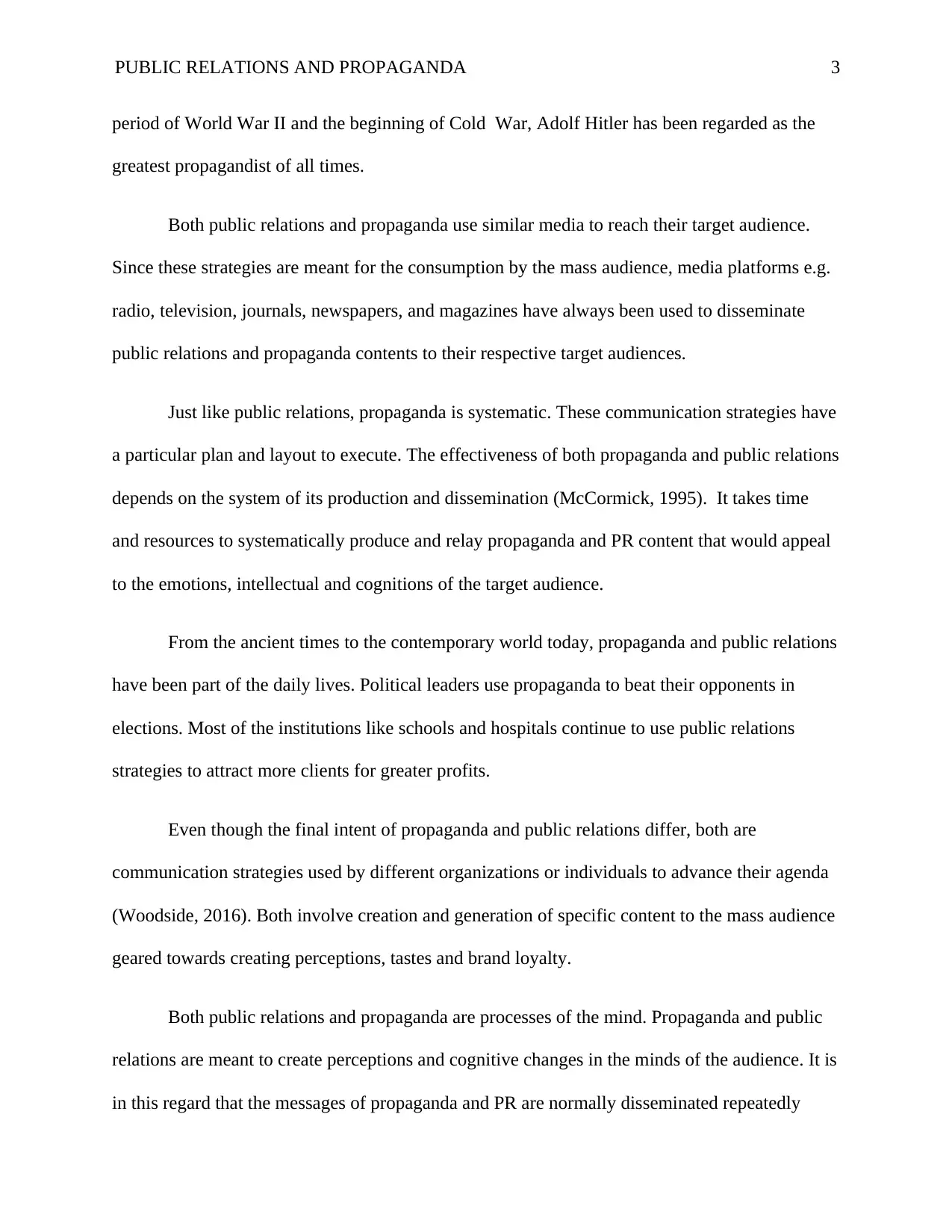
PUBLIC RELATIONS AND PROPAGANDA 3
period of World War II and the beginning of Cold War, Adolf Hitler has been regarded as the
greatest propagandist of all times.
Both public relations and propaganda use similar media to reach their target audience.
Since these strategies are meant for the consumption by the mass audience, media platforms e.g.
radio, television, journals, newspapers, and magazines have always been used to disseminate
public relations and propaganda contents to their respective target audiences.
Just like public relations, propaganda is systematic. These communication strategies have
a particular plan and layout to execute. The effectiveness of both propaganda and public relations
depends on the system of its production and dissemination (McCormick, 1995). It takes time
and resources to systematically produce and relay propaganda and PR content that would appeal
to the emotions, intellectual and cognitions of the target audience.
From the ancient times to the contemporary world today, propaganda and public relations
have been part of the daily lives. Political leaders use propaganda to beat their opponents in
elections. Most of the institutions like schools and hospitals continue to use public relations
strategies to attract more clients for greater profits.
Even though the final intent of propaganda and public relations differ, both are
communication strategies used by different organizations or individuals to advance their agenda
(Woodside, 2016). Both involve creation and generation of specific content to the mass audience
geared towards creating perceptions, tastes and brand loyalty.
Both public relations and propaganda are processes of the mind. Propaganda and public
relations are meant to create perceptions and cognitive changes in the minds of the audience. It is
in this regard that the messages of propaganda and PR are normally disseminated repeatedly
period of World War II and the beginning of Cold War, Adolf Hitler has been regarded as the
greatest propagandist of all times.
Both public relations and propaganda use similar media to reach their target audience.
Since these strategies are meant for the consumption by the mass audience, media platforms e.g.
radio, television, journals, newspapers, and magazines have always been used to disseminate
public relations and propaganda contents to their respective target audiences.
Just like public relations, propaganda is systematic. These communication strategies have
a particular plan and layout to execute. The effectiveness of both propaganda and public relations
depends on the system of its production and dissemination (McCormick, 1995). It takes time
and resources to systematically produce and relay propaganda and PR content that would appeal
to the emotions, intellectual and cognitions of the target audience.
From the ancient times to the contemporary world today, propaganda and public relations
have been part of the daily lives. Political leaders use propaganda to beat their opponents in
elections. Most of the institutions like schools and hospitals continue to use public relations
strategies to attract more clients for greater profits.
Even though the final intent of propaganda and public relations differ, both are
communication strategies used by different organizations or individuals to advance their agenda
(Woodside, 2016). Both involve creation and generation of specific content to the mass audience
geared towards creating perceptions, tastes and brand loyalty.
Both public relations and propaganda are processes of the mind. Propaganda and public
relations are meant to create perceptions and cognitive changes in the minds of the audience. It is
in this regard that the messages of propaganda and PR are normally disseminated repeatedly
⊘ This is a preview!⊘
Do you want full access?
Subscribe today to unlock all pages.

Trusted by 1+ million students worldwide
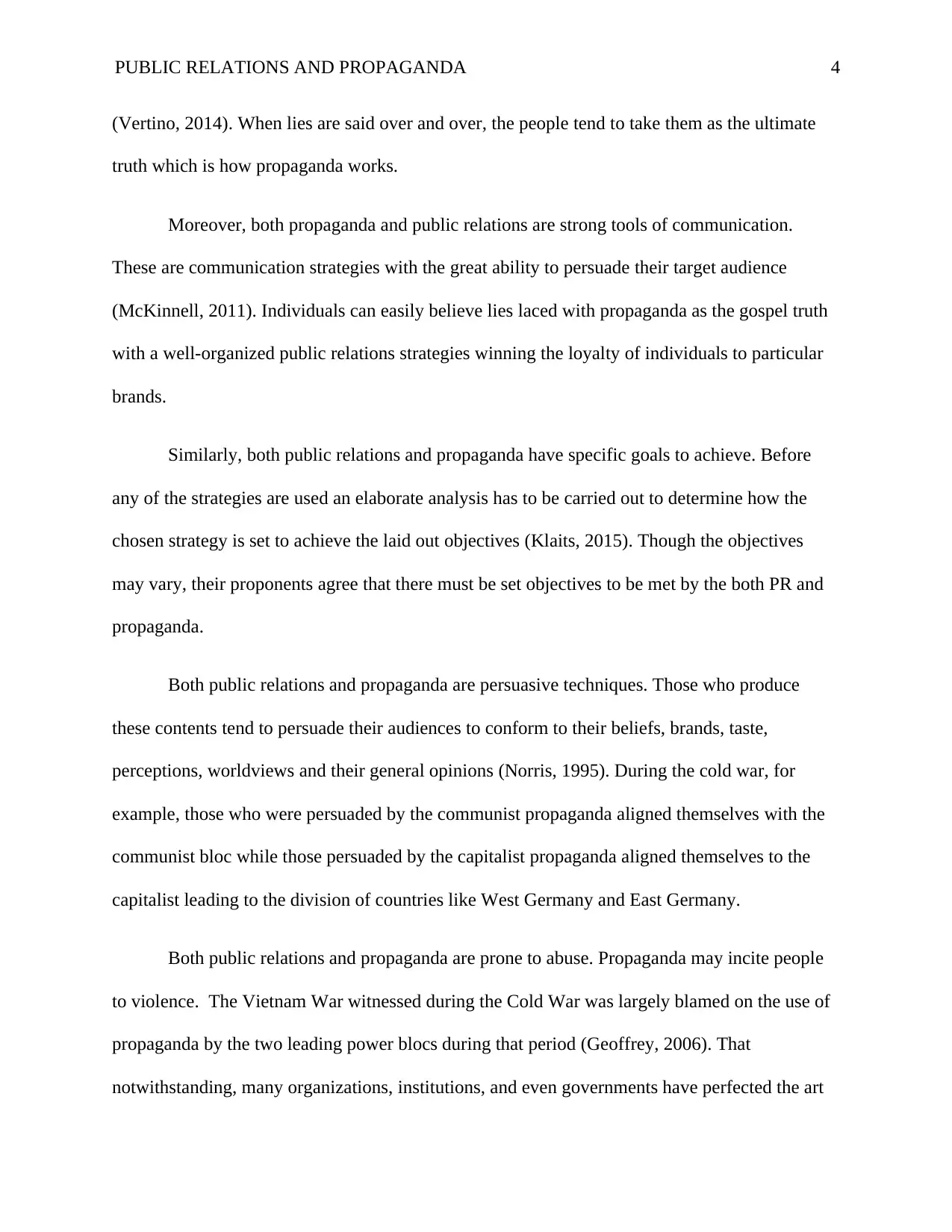
PUBLIC RELATIONS AND PROPAGANDA 4
(Vertino, 2014). When lies are said over and over, the people tend to take them as the ultimate
truth which is how propaganda works.
Moreover, both propaganda and public relations are strong tools of communication.
These are communication strategies with the great ability to persuade their target audience
(McKinnell, 2011). Individuals can easily believe lies laced with propaganda as the gospel truth
with a well-organized public relations strategies winning the loyalty of individuals to particular
brands.
Similarly, both public relations and propaganda have specific goals to achieve. Before
any of the strategies are used an elaborate analysis has to be carried out to determine how the
chosen strategy is set to achieve the laid out objectives (Klaits, 2015). Though the objectives
may vary, their proponents agree that there must be set objectives to be met by the both PR and
propaganda.
Both public relations and propaganda are persuasive techniques. Those who produce
these contents tend to persuade their audiences to conform to their beliefs, brands, taste,
perceptions, worldviews and their general opinions (Norris, 1995). During the cold war, for
example, those who were persuaded by the communist propaganda aligned themselves with the
communist bloc while those persuaded by the capitalist propaganda aligned themselves to the
capitalist leading to the division of countries like West Germany and East Germany.
Both public relations and propaganda are prone to abuse. Propaganda may incite people
to violence. The Vietnam War witnessed during the Cold War was largely blamed on the use of
propaganda by the two leading power blocs during that period (Geoffrey, 2006). That
notwithstanding, many organizations, institutions, and even governments have perfected the art
(Vertino, 2014). When lies are said over and over, the people tend to take them as the ultimate
truth which is how propaganda works.
Moreover, both propaganda and public relations are strong tools of communication.
These are communication strategies with the great ability to persuade their target audience
(McKinnell, 2011). Individuals can easily believe lies laced with propaganda as the gospel truth
with a well-organized public relations strategies winning the loyalty of individuals to particular
brands.
Similarly, both public relations and propaganda have specific goals to achieve. Before
any of the strategies are used an elaborate analysis has to be carried out to determine how the
chosen strategy is set to achieve the laid out objectives (Klaits, 2015). Though the objectives
may vary, their proponents agree that there must be set objectives to be met by the both PR and
propaganda.
Both public relations and propaganda are persuasive techniques. Those who produce
these contents tend to persuade their audiences to conform to their beliefs, brands, taste,
perceptions, worldviews and their general opinions (Norris, 1995). During the cold war, for
example, those who were persuaded by the communist propaganda aligned themselves with the
communist bloc while those persuaded by the capitalist propaganda aligned themselves to the
capitalist leading to the division of countries like West Germany and East Germany.
Both public relations and propaganda are prone to abuse. Propaganda may incite people
to violence. The Vietnam War witnessed during the Cold War was largely blamed on the use of
propaganda by the two leading power blocs during that period (Geoffrey, 2006). That
notwithstanding, many organizations, institutions, and even governments have perfected the art
Paraphrase This Document
Need a fresh take? Get an instant paraphrase of this document with our AI Paraphraser
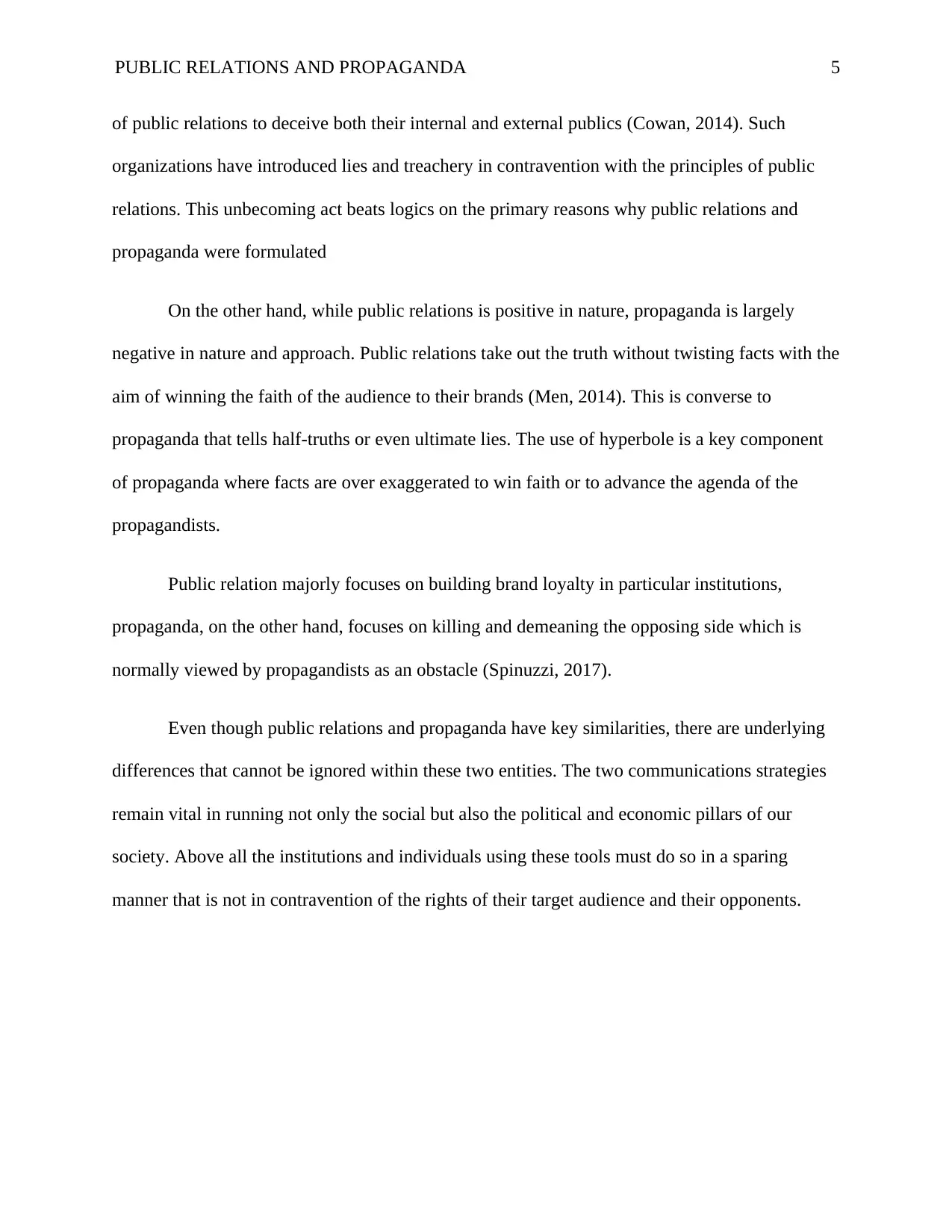
PUBLIC RELATIONS AND PROPAGANDA 5
of public relations to deceive both their internal and external publics (Cowan, 2014). Such
organizations have introduced lies and treachery in contravention with the principles of public
relations. This unbecoming act beats logics on the primary reasons why public relations and
propaganda were formulated
On the other hand, while public relations is positive in nature, propaganda is largely
negative in nature and approach. Public relations take out the truth without twisting facts with the
aim of winning the faith of the audience to their brands (Men, 2014). This is converse to
propaganda that tells half-truths or even ultimate lies. The use of hyperbole is a key component
of propaganda where facts are over exaggerated to win faith or to advance the agenda of the
propagandists.
Public relation majorly focuses on building brand loyalty in particular institutions,
propaganda, on the other hand, focuses on killing and demeaning the opposing side which is
normally viewed by propagandists as an obstacle (Spinuzzi, 2017).
Even though public relations and propaganda have key similarities, there are underlying
differences that cannot be ignored within these two entities. The two communications strategies
remain vital in running not only the social but also the political and economic pillars of our
society. Above all the institutions and individuals using these tools must do so in a sparing
manner that is not in contravention of the rights of their target audience and their opponents.
of public relations to deceive both their internal and external publics (Cowan, 2014). Such
organizations have introduced lies and treachery in contravention with the principles of public
relations. This unbecoming act beats logics on the primary reasons why public relations and
propaganda were formulated
On the other hand, while public relations is positive in nature, propaganda is largely
negative in nature and approach. Public relations take out the truth without twisting facts with the
aim of winning the faith of the audience to their brands (Men, 2014). This is converse to
propaganda that tells half-truths or even ultimate lies. The use of hyperbole is a key component
of propaganda where facts are over exaggerated to win faith or to advance the agenda of the
propagandists.
Public relation majorly focuses on building brand loyalty in particular institutions,
propaganda, on the other hand, focuses on killing and demeaning the opposing side which is
normally viewed by propagandists as an obstacle (Spinuzzi, 2017).
Even though public relations and propaganda have key similarities, there are underlying
differences that cannot be ignored within these two entities. The two communications strategies
remain vital in running not only the social but also the political and economic pillars of our
society. Above all the institutions and individuals using these tools must do so in a sparing
manner that is not in contravention of the rights of their target audience and their opponents.
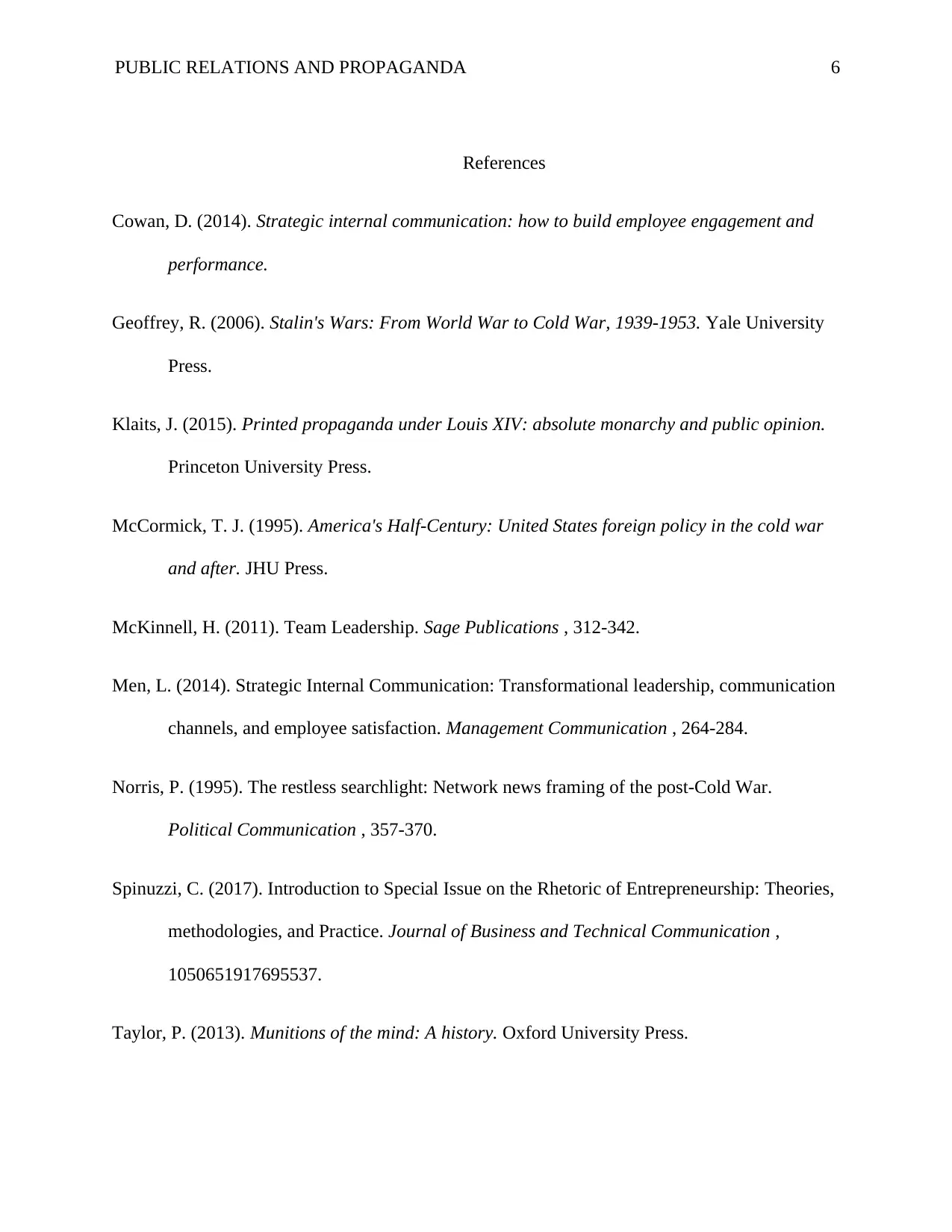
PUBLIC RELATIONS AND PROPAGANDA 6
References
Cowan, D. (2014). Strategic internal communication: how to build employee engagement and
performance.
Geoffrey, R. (2006). Stalin's Wars: From World War to Cold War, 1939-1953. Yale University
Press.
Klaits, J. (2015). Printed propaganda under Louis XIV: absolute monarchy and public opinion.
Princeton University Press.
McCormick, T. J. (1995). America's Half-Century: United States foreign policy in the cold war
and after. JHU Press.
McKinnell, H. (2011). Team Leadership. Sage Publications , 312-342.
Men, L. (2014). Strategic Internal Communication: Transformational leadership, communication
channels, and employee satisfaction. Management Communication , 264-284.
Norris, P. (1995). The restless searchlight: Network news framing of the post-Cold War.
Political Communication , 357-370.
Spinuzzi, C. (2017). Introduction to Special Issue on the Rhetoric of Entrepreneurship: Theories,
methodologies, and Practice. Journal of Business and Technical Communication ,
1050651917695537.
Taylor, P. (2013). Munitions of the mind: A history. Oxford University Press.
References
Cowan, D. (2014). Strategic internal communication: how to build employee engagement and
performance.
Geoffrey, R. (2006). Stalin's Wars: From World War to Cold War, 1939-1953. Yale University
Press.
Klaits, J. (2015). Printed propaganda under Louis XIV: absolute monarchy and public opinion.
Princeton University Press.
McCormick, T. J. (1995). America's Half-Century: United States foreign policy in the cold war
and after. JHU Press.
McKinnell, H. (2011). Team Leadership. Sage Publications , 312-342.
Men, L. (2014). Strategic Internal Communication: Transformational leadership, communication
channels, and employee satisfaction. Management Communication , 264-284.
Norris, P. (1995). The restless searchlight: Network news framing of the post-Cold War.
Political Communication , 357-370.
Spinuzzi, C. (2017). Introduction to Special Issue on the Rhetoric of Entrepreneurship: Theories,
methodologies, and Practice. Journal of Business and Technical Communication ,
1050651917695537.
Taylor, P. (2013). Munitions of the mind: A history. Oxford University Press.
⊘ This is a preview!⊘
Do you want full access?
Subscribe today to unlock all pages.

Trusted by 1+ million students worldwide
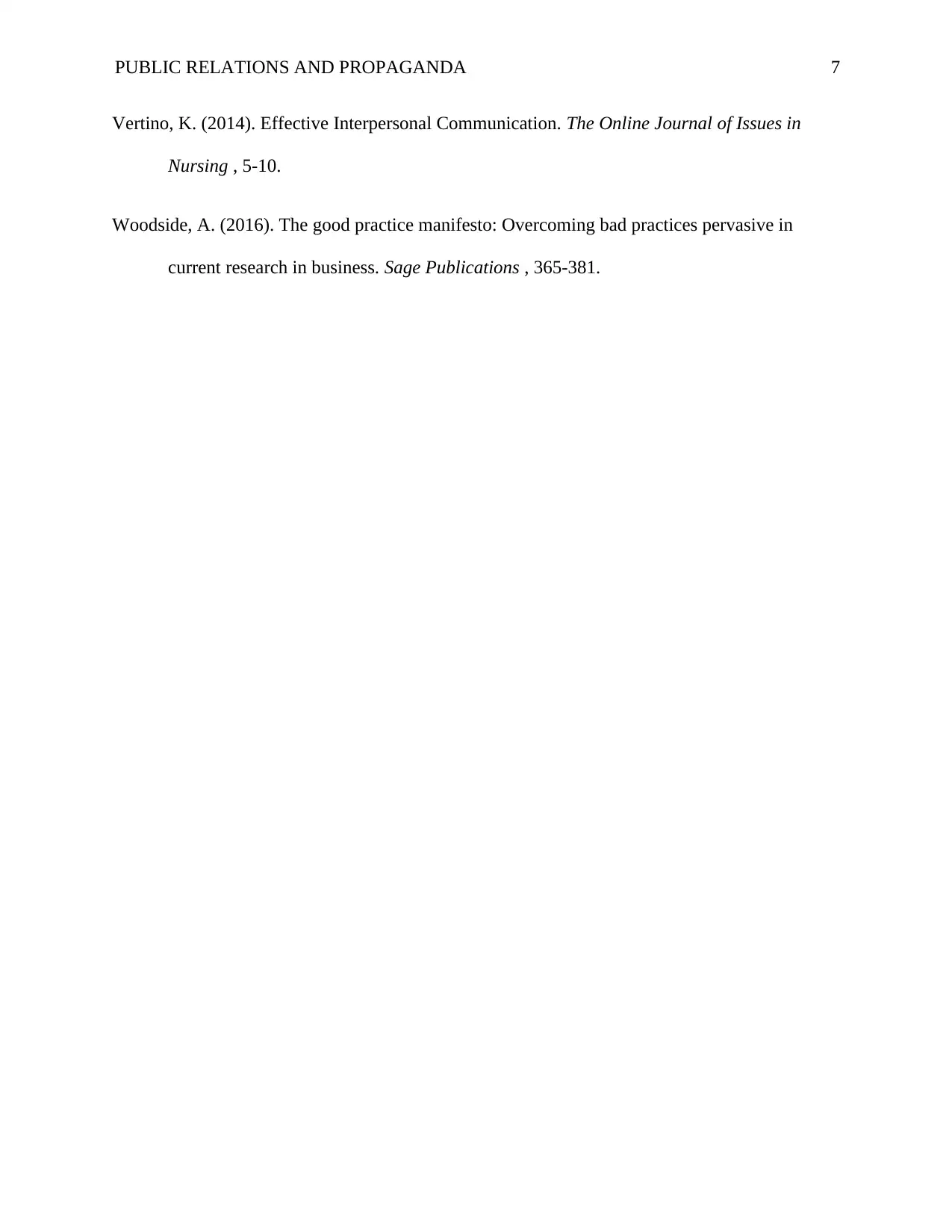
PUBLIC RELATIONS AND PROPAGANDA 7
Vertino, K. (2014). Effective Interpersonal Communication. The Online Journal of Issues in
Nursing , 5-10.
Woodside, A. (2016). The good practice manifesto: Overcoming bad practices pervasive in
current research in business. Sage Publications , 365-381.
Vertino, K. (2014). Effective Interpersonal Communication. The Online Journal of Issues in
Nursing , 5-10.
Woodside, A. (2016). The good practice manifesto: Overcoming bad practices pervasive in
current research in business. Sage Publications , 365-381.
1 out of 7
Related Documents
Your All-in-One AI-Powered Toolkit for Academic Success.
+13062052269
info@desklib.com
Available 24*7 on WhatsApp / Email
![[object Object]](/_next/static/media/star-bottom.7253800d.svg)
Unlock your academic potential
Copyright © 2020–2025 A2Z Services. All Rights Reserved. Developed and managed by ZUCOL.




